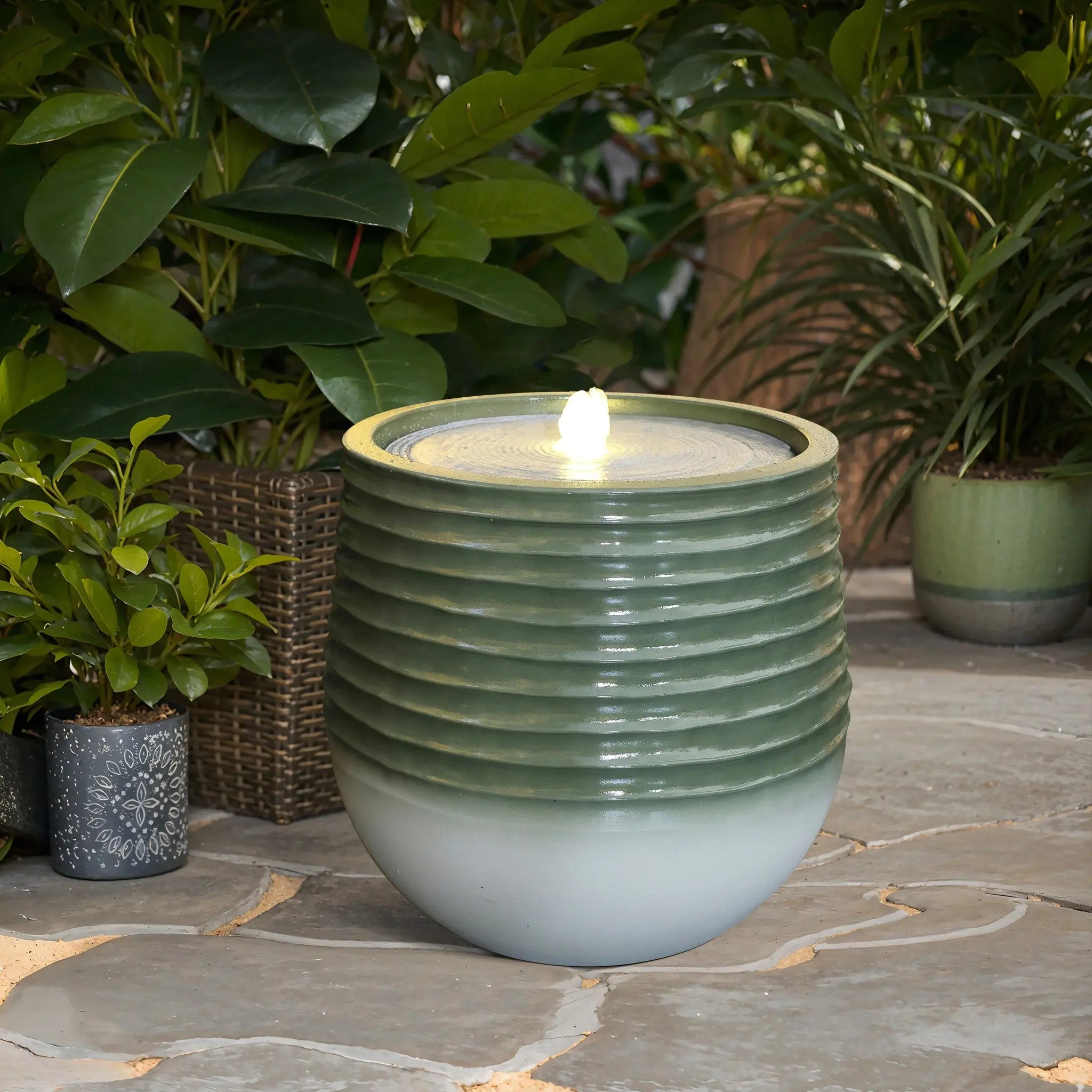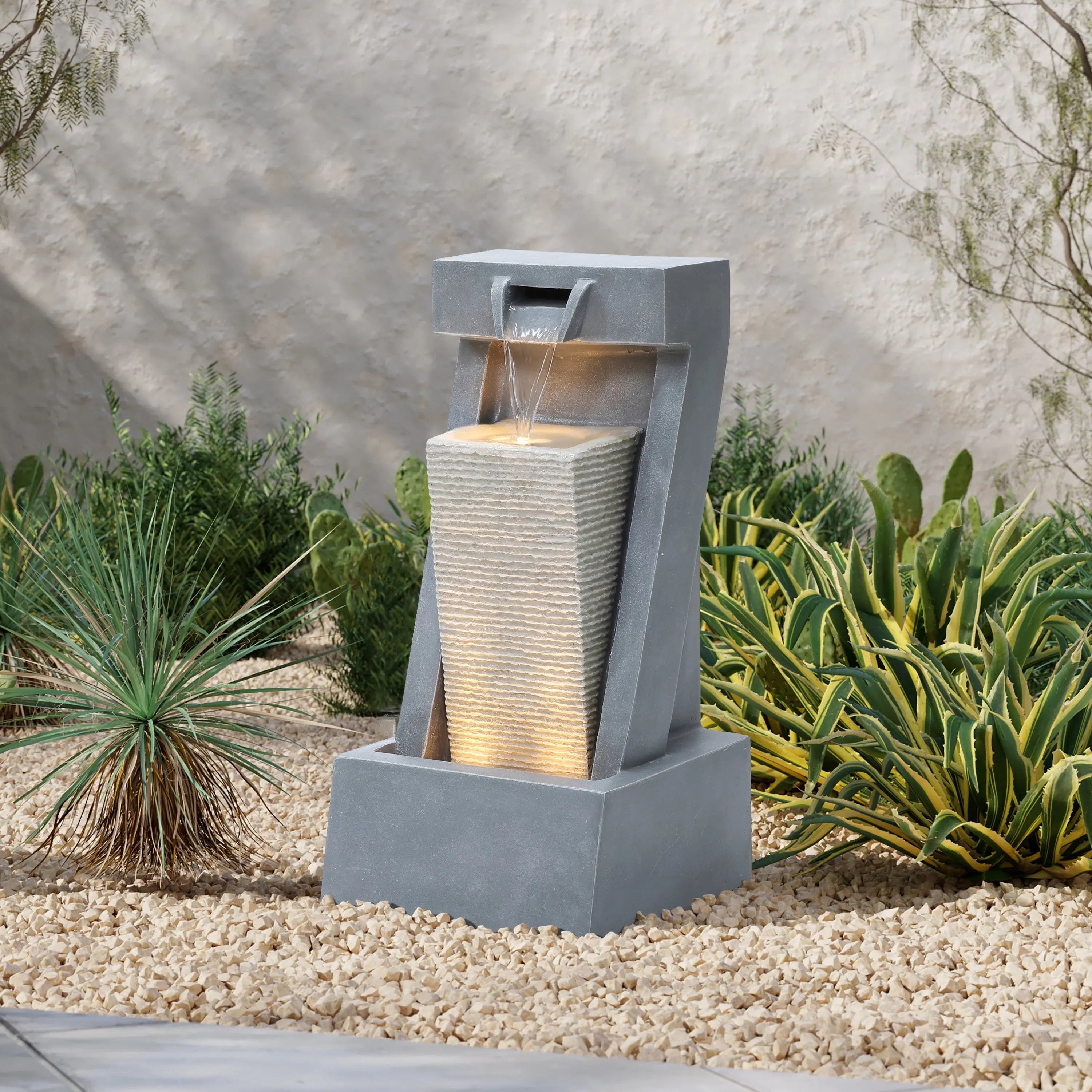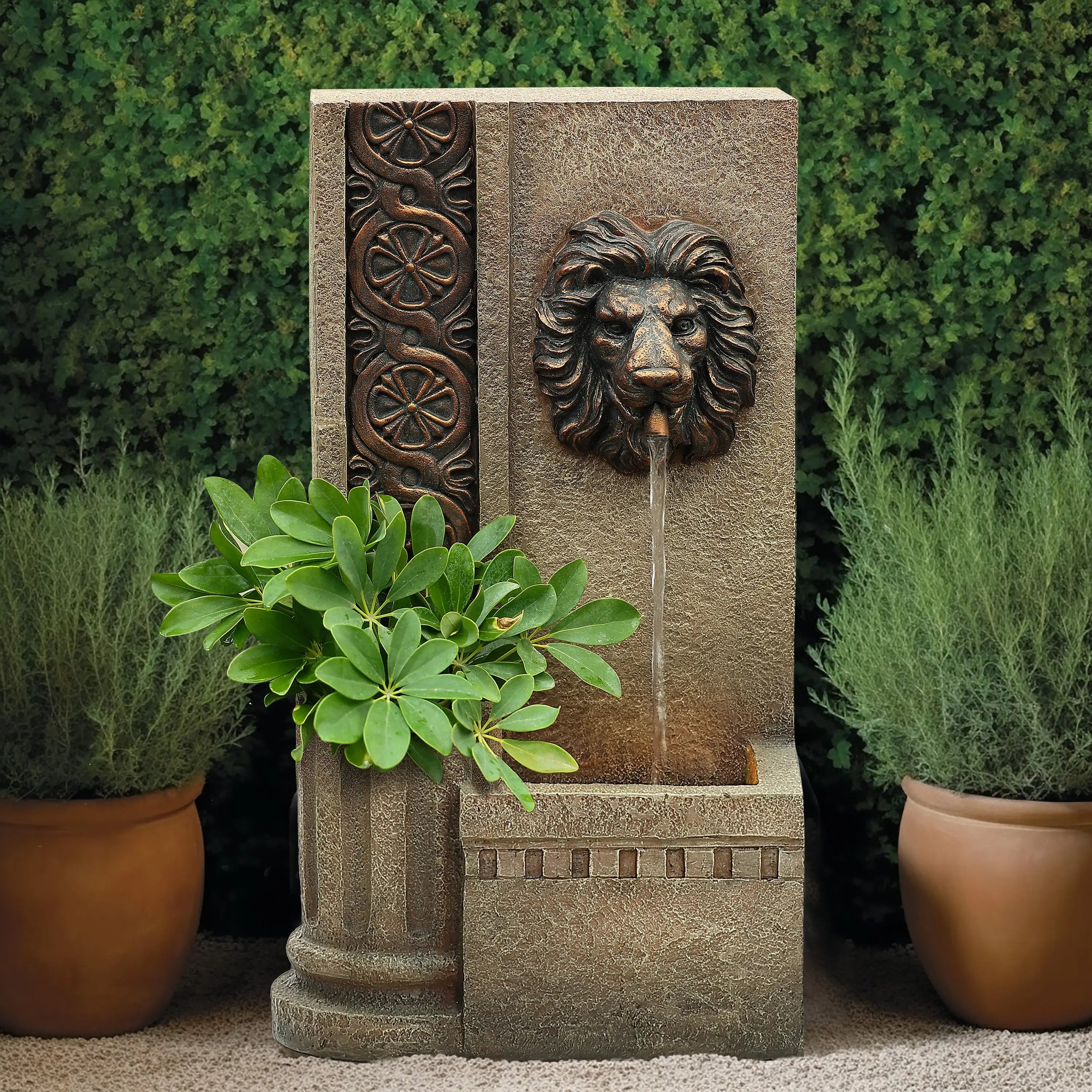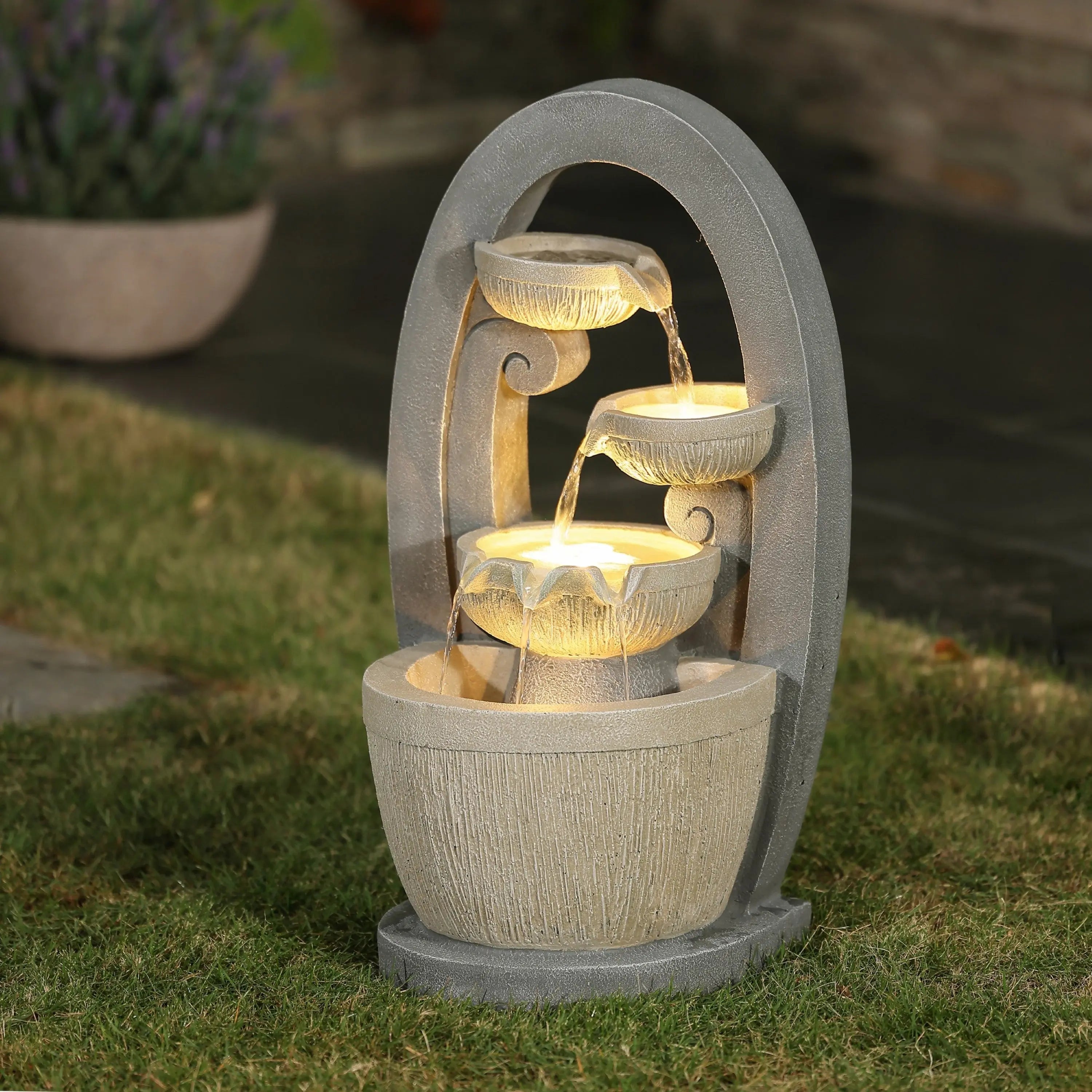Water features have an alluring charm that transcends time and trends. The gentle yet persistent flow of water can be calming, transforming any space into a serene oasis. However, where you decide to install a fountain—be it the living room or the garden—has a significant impact on its role and function. We’ll explore the differences between indoor and outdoor water fountains to help you evaluate which type is most suited to your personal space, like a garden, backyard, or patio.
A Closer Look at Indoor Water Fountains
Indoor water fountains are a stylish addition to any home interior, serving as a focal point that draws the eye and soothes the mind. They come in various sizes and designs, from table-top options to larger structures that you can incorporate into the structure of your home. Typically, indoor fountains are less intrusive, fitting into any theme without overwhelming the room.

Shapes, Sizes & Popular Materials
-
Tabletop & desk models (under 12 inches) are perfect for apartments and dorms because they plug into a standard outlet and use just a quart of water.
-
Wall-mounted panels in stainless steel or tempered glass double as art and create white noise that helps mask office chatter.
-
Freestanding columns leverage lightweight resin or fiberglass so they can be moved without damaging hardwood floors.
Water & Air Management
A closed-loop pump keeps splashing to millimeters, while evaporation adds a gentle boost of humidity that can ease dry-air headaches and help houseplants thrive.
Since they don’t need to hold up to the elements, indoor fountains have the added benefit of requiring less maintenance. However, you must meet specific conditions for their placement. You need to consider humidity levels, water splashing, and the overall style cohesion. The key lies in selecting a design that complements your space while ensuring the placement doesn't create any water damage or hazards.
The Majesty of Outdoor Water Fountains
Outdoor water fountains, on the other hand, have the advantage of scale. They can be grand and expansive, becoming a central part of your garden's design, or smaller and more subtle, depending on your needs. These fountains are specially designed to withstand the elements, often crafted from hardy materials like stone, ceramic, or cast iron. They are a statement piece, adding a touch of elegance or a sense of playfulness to your outdoor relaxation space.

Types, Shapes & Weather-Proof Materials
| Type | Ideal Setting | Common Material | Quick Take |
|---|---|---|---|
| Tiered classical | Formal lawns | Cast stone | Dramatic cascade and bird-friendly basins |
| Rustic rockfall | Woodland corners | Concrete + faux-stone finish | Blends into natural landscaping |
| Solar bowl | Balcony or rental patio | Polyresin | Zero wiring; runs on sunlight |
| Electric water fountains outdoor | Courtyard focal point | Concrete/metal | Reliable flow, supports LED lighting |
Installation & Seasonal Care
With outdoor fountains, you may have more creative freedom to experiment with the design and scale, but the installation and ongoing care are typically more involved.
You'll need to consider factors such as plumbing, electricity, and protecting the fountain from wildlife or leaves that may disrupt its flow. Outdoor units need a GFCI circuit, a solid base, and seasonal shutdowns. Draining, cleaning, and covering before nightly lows hit 40 °F (4 °C) prevents cracks and pump damage.
Comparing Indoor and Outdoor Fountains
Now that you know your options, it’s time to break down the differences between indoor and outdoor water fountains in more detail.

For one, an indoor water fountain is usually smaller and placed in a controlled environment, making installation simpler. These fountains are also less costly since they use fewer robust materials. They do, however, need frequent cleaning, and you need to change the water often to prevent mold and algae growth.
Outdoor fountains are a larger investment initially, but their maintenance might be less burdensome over time due to more stable water conditions. Their larger size and construction often make outdoor fountains more expensive and more complex to install, requiring professional support.
Why They Aren’t Interchangeable
Indoor and outdoor fountains may share the same soothing essence of flowing water, but their designs are governed by environmental laws as unyielding as gravity. Attempting to swap them isn’t just impractical—it risks structural harm, safety breaches, and costly repairs. Below, we dissect the three pillars that anchor each fountain type to its intended habitat.
Humidity & Splash
Indoor spaces can’t handle the evaporation and splashing of outdoor designs. Open-air fountains release significant moisture, warping floors and fostering mold. Indoor models use sealed systems and splash guards to limit humidity, while outdoor units prioritize airflow and drainage.
Material Durability
Indoor materials like resin or lightweight ceramics crack under UV rays or freezing temperatures. Outdoor fountains rely on weatherproof polymers, stainless steel, or sealed stone to resist thermal expansion, fading, and corrosion.
Electrical Safety
Outdoor pumps require waterproof, heavy-duty wiring (e.g., 12-gauge cords) and GFCI outlets to prevent shorts in rain. Indoor pumps use lighter cords unsuited for moisture. Solar hybrids or dual-certified models are the only exceptions.

Choosing the Right Fountain: 5 Quick Questions
The decision between indoor and outdoor water fountains ultimately comes down to personal preference, outdoor space, and practicality. Each type offers a unique experience, and the right choice for your home will enhance its aesthetic and provide tranquility for you and your guests.
If you really can't decide, when choosing an indoor or outdoor fountain, maybe you can ask the following five questions? Maybe they can help you choose the fountain that's best for your home.
1. Footprint: How Much Space Can You Dedicate?
- Indoor: Measure your floor or surface area, then add a 6-inch buffer to account for splashes and humidity dispersion. For example, a 24-inch tabletop fountain needs 30 inches of clearance. Avoid corners with poor airflow—stagnant moisture invites mold.
- Outdoor: Allow a 12-inch perimeter around the fountain to prevent soil erosion and water damage to decks or walls. Use landscape stakes and string to visualize the zone.
2. Desired Sound: What’s Your Acoustic Goal?
- Indoor Serenity: Opt for gentle, rhythmic flows like a glass-panel wall fountain to mask tinnitus or enhance meditation. Avoid cascading designs—they’re louder and risk humidity spikes.
- Outdoor Ambiance: Tiered stone bowls or cascading copper fountains generate 60-70 decibels of white noise, ideal for drowning out traffic or noisy neighbors. Test sound levels with apps like Decibel X before installing.
3. Climate: Will Weather Dictate Durability?
- Freezing Winters: Choose removable pumps or solar models with detachable basins. Avoid porous materials like sandstone—they crack in freeze-thaw cycles.
- Humid Regions: Prioritize stainless steel or UV-stabilized resin to resist mold and fading. Bonus: Add a mosquito dunk to outdoor water to deter pests.
4. Power: What’s Your Energy Reality?
- Outdoor Wiring: Solar fountains save $300+ in trenching costs but require 4+ hours of direct sunlight. For shaded areas, hybrid models with battery backups are essential.
- Indoor Safety: Ensure outlets are GFCI-protected if near water. Smart plugs can automate daily dry cycles to prevent stagnation.
5. Style: What’s Your Design Language?
- Modern: Sleek resin columns, corten steel cubes, or glass-and-metal combos.
- Rustic: Weathered stone, hammered copper, or reclaimed wood basins.
- Transitional: Blend materials—try a geometric concrete fountain with a teak base.
6. Budget: What’s the True Total Cost?
-
Prepaid: Includes shipping, foundation preparation, and professional assembly (optional).
Annual: Set aside money for sealants, algae treatments, and pump replacements. Solar saves money long term, but costs 20% more upfront.
Conclusion
LuxenHome has fountains for any possible need, whether you’re looking for something smaller for your home’s interior or a statement piece for your yard.
Our bubbling outdoor fountains are especially popular, thanks to their unique sounds that really set the atmosphere of a space. Browse our collection today to find the perfect fountain for your home or business.
FAQs
Q: Can I use my outdoor fountain indoors temporarily?
A: Only if it’s explicitly labeled “dual-use.” Standard outdoor fountains often lack quiet pumps and may expose indoor spaces to excess moisture or mold-prone materials.
Q: How do I prevent algae in my indoor fountain?
A: Use distilled water, avoid direct sunlight, and add a UV clarifier or natural enzyme treatment. Clean the pump filter every two weeks.
Q: Are outdoor fountains safe around pets?
A: Opt for splash-free designs with covered wiring and avoid toxic materials like certain metals or treated stones. Always secure electrical connections with waterproof casings.

Leave a comment